Owning to the ease, fishkeeping is very popular hoppy nowadays. Generally, beginners go for freshwater tanks as they are easy to maintain. But the question is, which fish should you choose for your first aquarium? Many people recommend angelfish as they are beautiful to look at and relatively easy to care for. So, are angelfish freshwater or saltwater fish, then?
The answer is both, depending on the species of angelfish. There are two types of angelfish- freshwater and saltwater. The most common type of angelfish kept as a pet is the freshwater angelfish. They are relatively easy to care for and can be kept in a community tank with other peaceful fish. However, saltwater angelfish are more difficult to care for and requires a more specialized setup.
Today, here in this article, we will discuss both freshwater and saltwater fish and some ways to care for Angelfish. However, before digging in, let’s know a little about Angelfish first.
What Type Of Fish Is Angelfish?
Angelfish is a very beautiful and popular fish that can be of different types and varieties. Generally, this fish is a tropical fish that originally came from South America. The scientific name for this fish is Pterophyllum scalare.
Angelfish are semi-aggressive fish and they can grow to be about 4 to 10 inches long. These fish are available in a wide variety of colors, including blue, gold, silver, and black. In addition to this, they also have long fins, and their bodies are tall and elongated.
Most aquarists choose Angelfish because they are very attractive fish. They are also very peaceful, which makes them a good choice for community tanks. However, they do not realize that Angelfish can be both freshwater and saltwater fish.
Are Angelfish Freshwater Or Saltwater Fish?
While angelfish can technically survive in both freshwater and saltwater environments, it is important to know that they are not meant to live in both.
Angelfish are freshwater fish that come from rivers in South America. They come from the Cichlid family and can live in saltwater for a short period of time. But since their bodies are not built to handle the extra salt when angelfish are put into saltwater, they will start to experience stress and their immune system will weaken. This makes them more susceptible to diseases and parasites.
Similarly, saltwater Angelfish comes from the ocean. These fish belongs to the Pomacanthidae family and can live in freshwater for a short period of time. However, putting saltwater Angelfish into freshwater will also cause stress and lead to various health issues.
The best thing you can do for your angelfish is to provide them with the proper environment they need based on their natural habitat. If you have a freshwater angelfish, keep them in a freshwater tank. And if you have a saltwater angelfish, keep them in a saltwater aquarium. This will help ensure that your fish stay healthy and happy for years to come!
But how to identify whether your fish is freshwater or Saltwater?
10 Freshwater Angelfish
As mentioned above, freshwater is thought to be a little easier to keep than saltwater Angelfish. And also, according to my experience, I too feel that they are a little easier to keep. Here are some of the freshwater Angelfish that I have kept over the years:
Zebra Angelfish
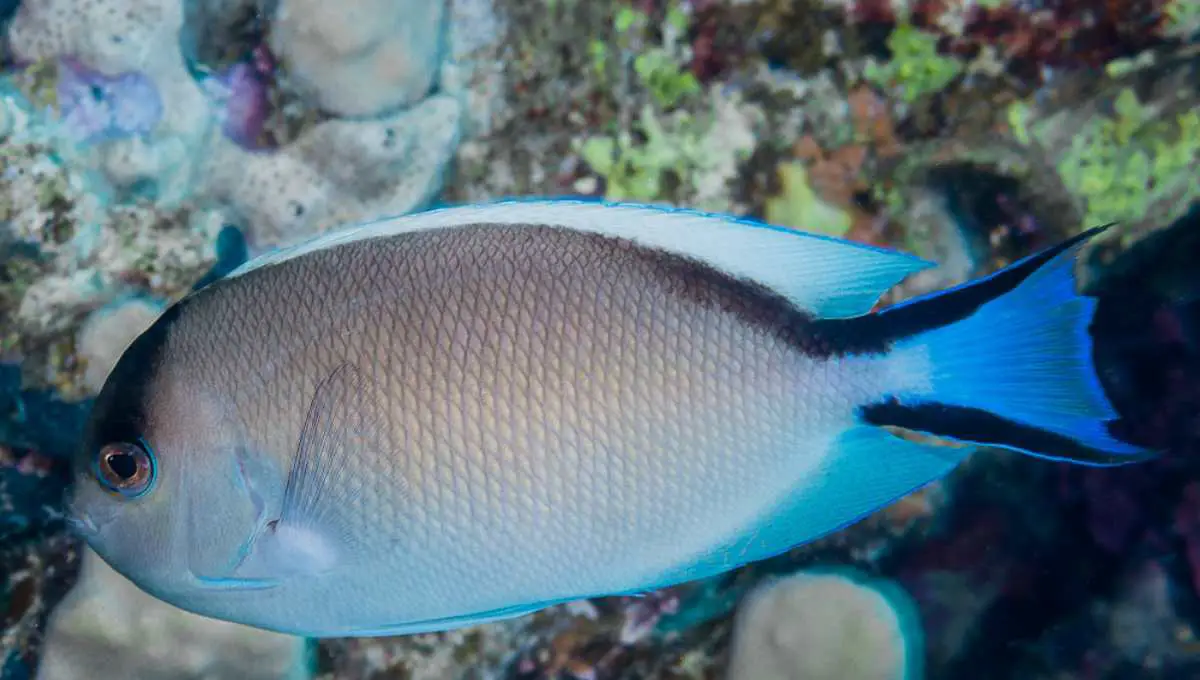
The Zebra Angelfish is one of the most popular freshwater angelfish. They are a little smaller and very energetic fish. So, you must consider these things while you keep them with other fish. Keeping them with bigger tankmates might stress and scare them off.
Moreover, this fascinating fish has six distinct sliver stripes all over its body and one at the back of its eyes. These lines make it easier for beginners to differentiate. Also, some zebra angels might develop red eyes after maturing (although it is not very visible).
Proper water maintenance with regular cleaning and gravel vacuuming is a must for them to stay healthy and happy. So, these are some things that you should know about zebra angels.
Koi Angelfish

If you are a fan of the koi goldfish, here’s a piece of good news for you- you can find koi angels for your aquarium too! These beauties have white, orange, and gold-colored flattened bodies with some red patches beneath their eyes. However, the sad part of it is that their patches disappear with age.
Usually, Koi angel’s color might change according to their mood. When they feel stressed, their body tone darkens. Although this sounds fascinating, it might be a serious sign. So, you should better consult professional help immediately;y when you notice such a change.
Altum Angelfish
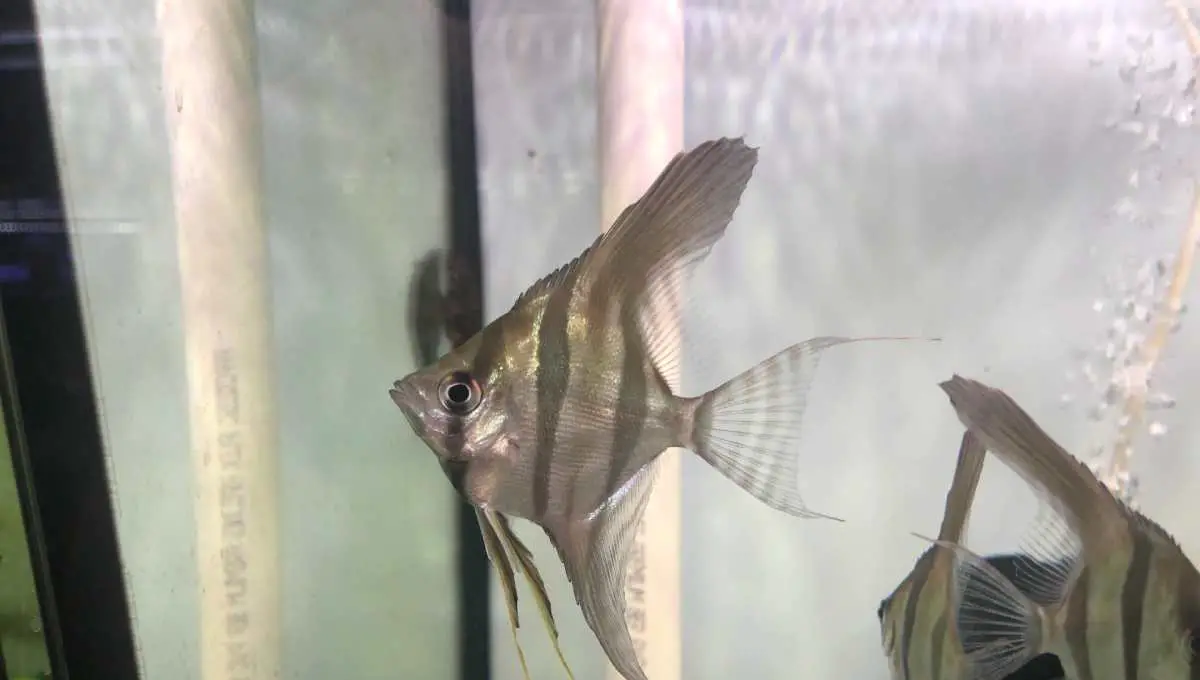
Usually, Altum angelfish are not common among aquarists. You must research a lot to find these beautiful Orinoco or blue angelfish. However, since these are the biggest angels, you can find them in wild habitats easily.
Once you set your mind to keeping these blue angels, you need a bigger tank with proper water parameters (temperature: 70-90 degrees Fahrenheit, pH: 4-6.5, and soft water with dH<5). However, you need a bit of extra work to keep this fish. But I bet the magnificent masterpiece with a silver body and brown/red stripes will be worth it.
Albino Angelfish
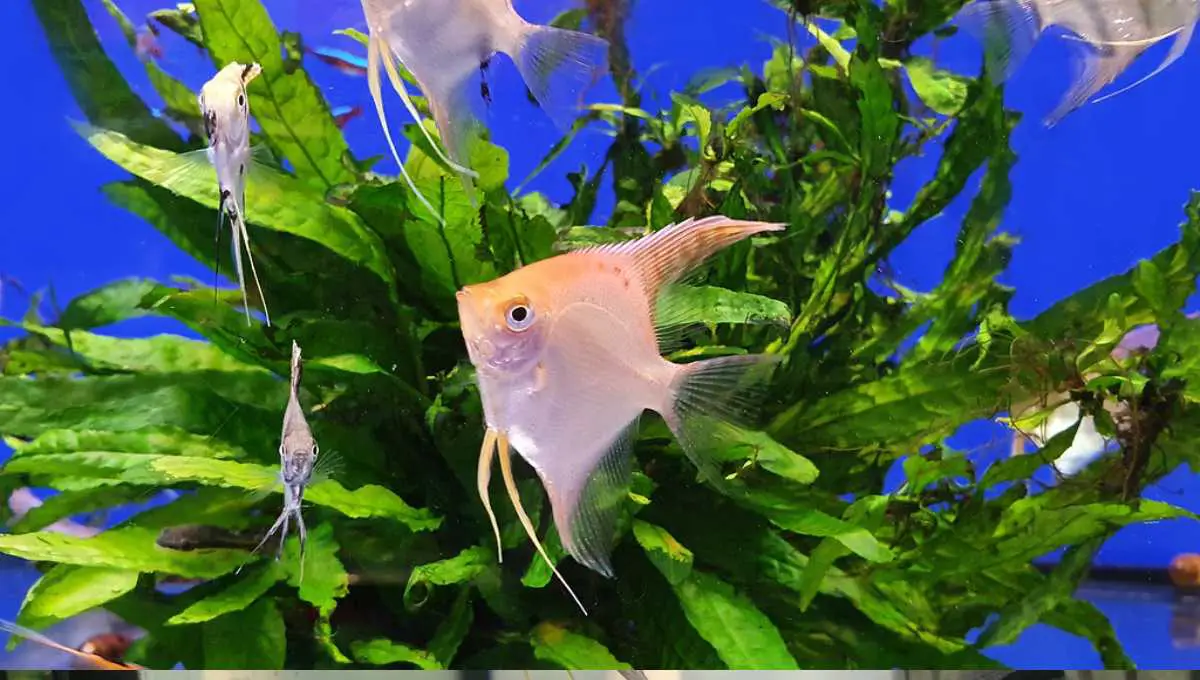
Another dramatic and flashy angelfish that is not too common among aquarists is an Albino angelfish. These beautiful fish has a very short lifespan and are susceptible to various health problems. Thus, most aquarists do not prefer keeping them.
However, if you are someone that wants to stay out of the ordinary, albinos will be a perfect addition to your tank. Once you get introduced to this fish, you will be in love with its peculiar pink eyes and faint gold stripes distributed around the edges. Actually, you will find it hard to take your eyes off them if you see them in proper lights.
But since these fish are a result of mutation, you just need to be very careful if you decide to keep them. If you don’t have time, it’s best to choose other options.
Veil Angelfish
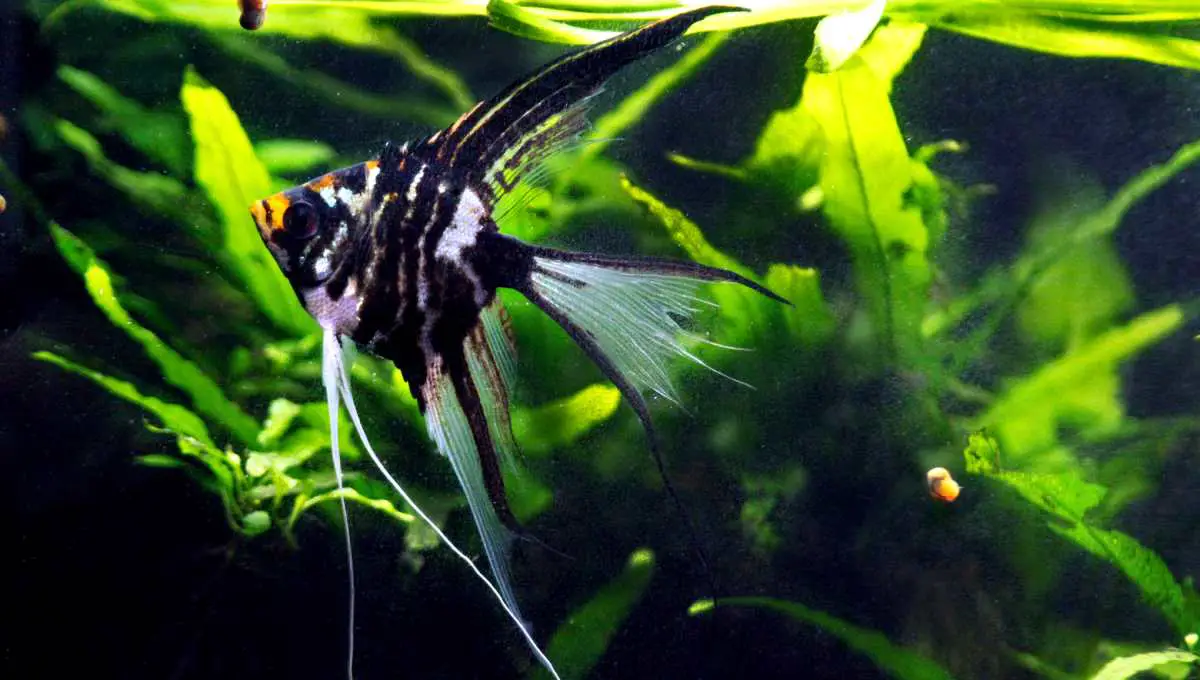
Veil angels are one of the most magnificent fish with beautiful fins of various colors. There’s no way anyone can’t notice their elegant fins and get attached to them. Therefore, they are loved and liked by many aquarists.
Owning to the immense hard work of breeders, a large number of veil angels are present today with various types and colors of fins. So, you can get your favorite color and type of veil angel without any hassle. While a single gene produces typical veil angels, two genes result in complex ones with magnificent fins.
However, this beautiful fish still hold some drawbacks. For instance, their fins and tails get decayed easily as they move at a slow pace. So, you need to be careful about it. And also, Veil angelfish cost a bit more than other species.
Black Lace Angelfish
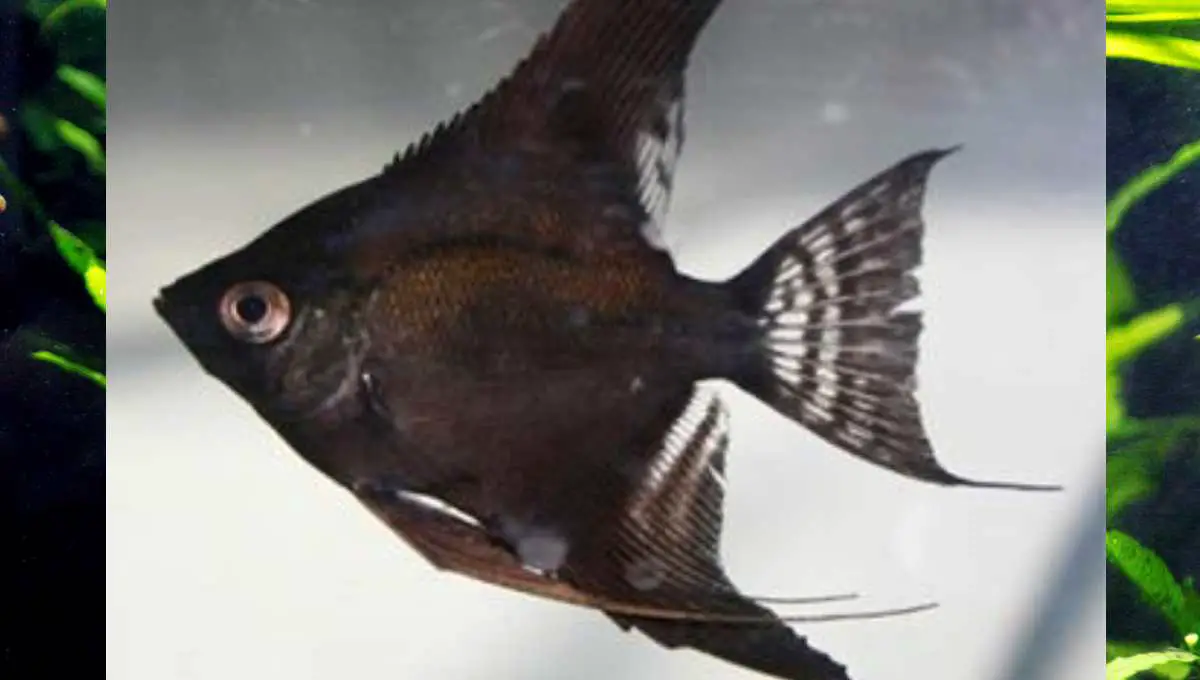
Black lace Angelfish is a mutant species of Zebra Angelfish. They originated when the extra genes possessing silver and zebra angelfish were crossed. Usually, the black lace angelfish are the ones that carry only one dark gene, while the angelfish carrying two or more dark genes are called labeled black, double blacks, or double darks.
With proper care and lighting, their trailing fins can be 14 inches tall, and you will notice subtle patterning just like zebra angelfish in them. In addition to this, black lace angelfish are quiet fish that aren’t much active. So, to keep them happy and healthy, it’s best to keep their aquarium in noise-free areas.
Leopard Angelfish
Leopard angelfish are also an interbred that originated by breeding common fish with captive-bred fish. Owing to the roots, these fish have very beautiful spots present on their sides. Undoubtedly, they are one of the best-looking angelfish.
But their beauty comes with a little effort and caution. If you want the spots of your Leopard angelfish to stay clear and dazzling, you must keep them in proper water condition and lightning. In addition to this, leopard angels are hardier than other interbred species and also comes in various types of spots.
So, if you are up for a little care, then surely leopard angelfish will be best for your freshwater aquarium.
Silver Angelfish
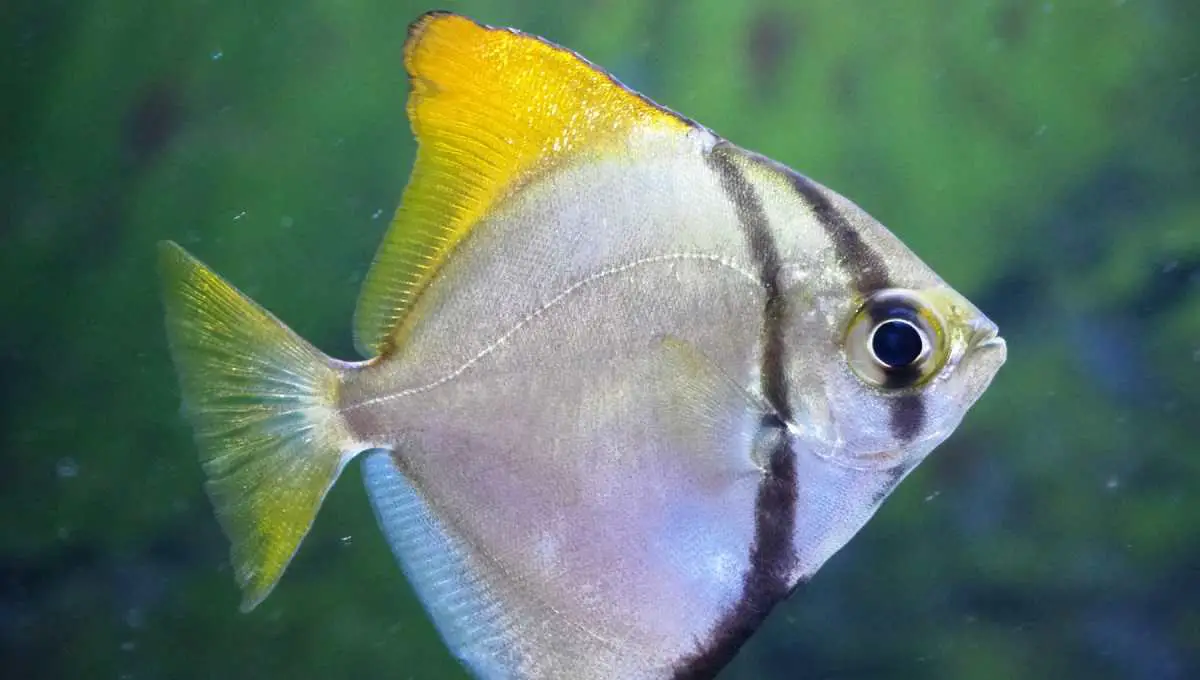
Silver Angelfish are exactly like common angelfish and serve as the original genetic material for breeders. They are very beautiful and angelfish, with silver bodies and three distinct stripes (two that go along the body and one above the head). But these stripes and colors might fade as per their mood and health, so you need to be cautious about it.
Moreover, Silver angels are quite hardier and easy to care for as compared to others. In addition to this, these fish are also very easy to feed. So, you can enjoy silver angels in your freshwater aquarium without much effort. However, the only thing that you need to care about a little more is their eating habit as they tend to over-eat.
Marble Angelfish
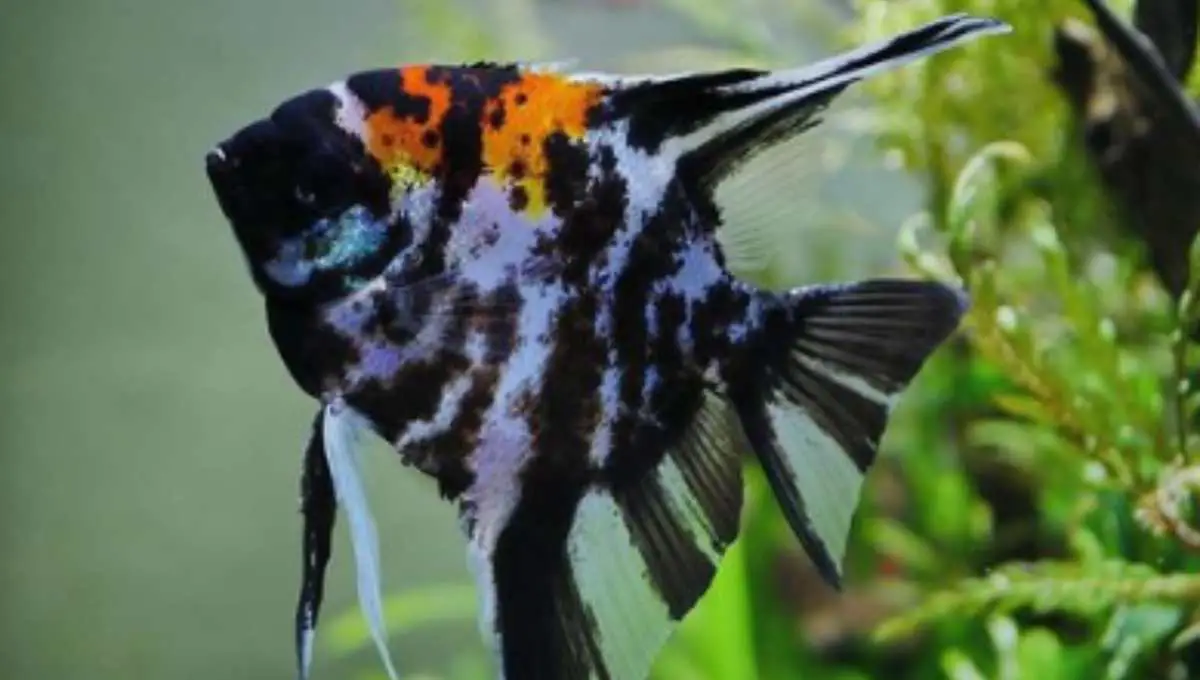
Marble Angelfish are undoubtedly the most elegant angels of all, with all the best features combined in one. Their beautiful swirling patterns of silver, orange, black and white color with temperate nipping habit and lesser flowing fish makes them undeniably magnificent. Moreover, these angels will pop in color and variety to your aquarium because every one of them looks different.
Generally, marble angels hold strong genetics that makes them hardier and resistant to many diseases. Also, these fish can adjust to fluctuating water conditions as well. With their beautiful patterns and common availability, they steal the hearts of many aquarists.
I, too, suggest you get Marble angelfish if you want variety in your place with lesser effort.
Gold Angelfish
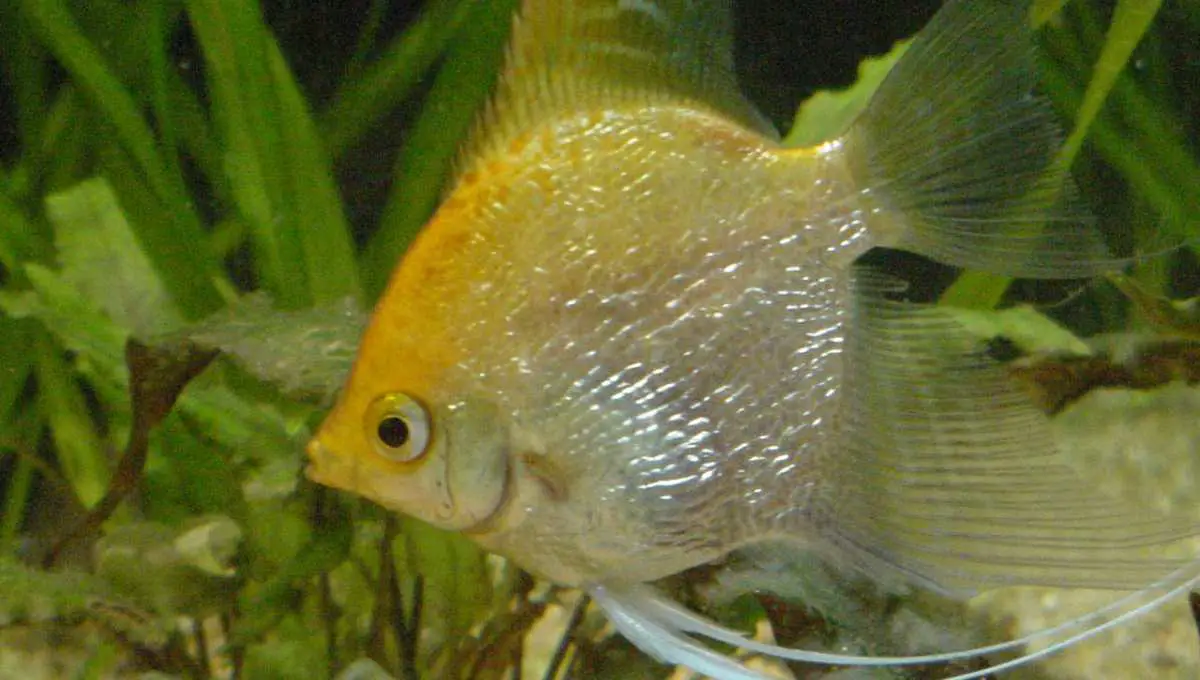
Gold Angelfish are the ones that took a little time to come out. In the 1960s, a breeder saw them first in the group of black lace angels. Then, after some meticulous breeding, he turned the recessive characteristics of gold fry into a batch that came out to be Gold Angelfish.
Since Gold angelfish have silver ancestry, they share gold and silver patterns. Usually, the fry takes a lot of time to show their deep gold color. And you must be very careful about their water conditions and diet to make sure that their colors pop out.
But overall, they are very beautiful and make a great addition to your freshwater aquarium.
So, these were some of the most beautiful angelfish that you can keep in your freshwater aquarium.
Now, let’s move towards saltwater angels!
10 Saltwater Angelfish: Which One Will You Choose?
Saltwater Angelfish are bigger and more colorful fish than freshwater angels that belongs to the family Pomacanthidae. There are more than 100 species of saltwater angelfish, and they can be found in tropical reefs throughout the world’s oceans.
It’s no secret that saltwater angelfish are some of the most beautiful fish in the world. But with so many different types to choose from, it can be hard to decide which one is right for your aquarium.
Here are 10 of the most popular saltwater angelfish:
Flame Angelfish
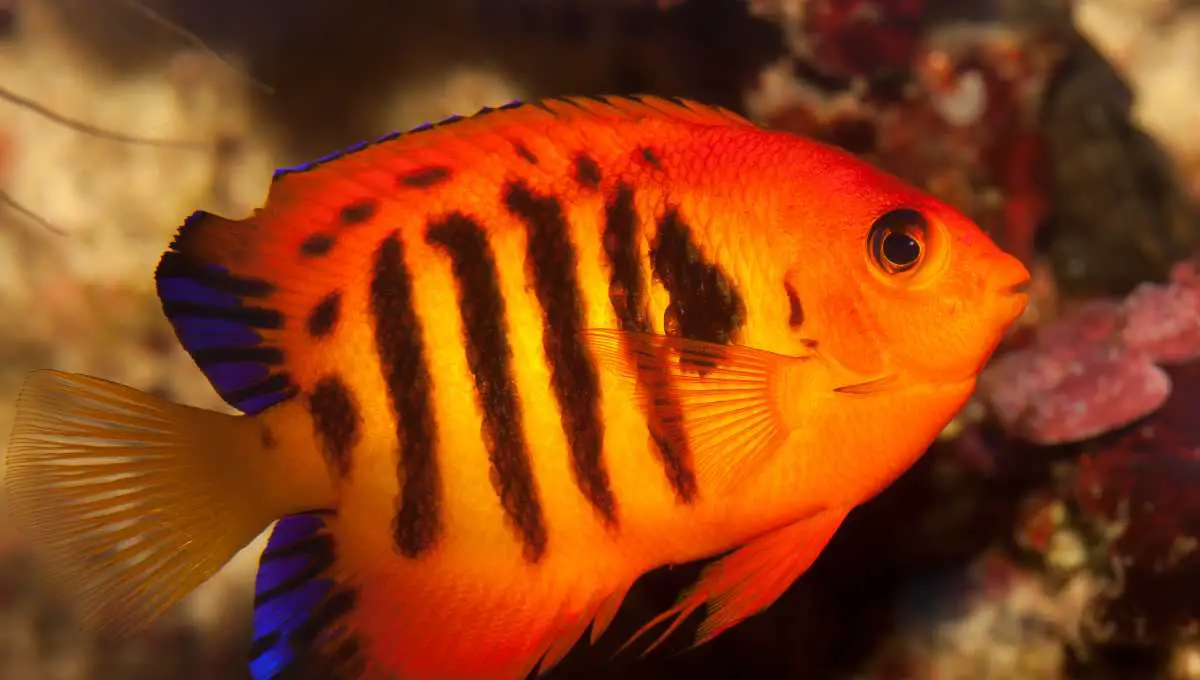
Flame Angelfish (Centropyge loricula) are small angelfish also popular as dwarf angels. Owing to their bright orange, black, blue, and yellow accents, they look like dancing flames. Generally, they are present in the Indo-Pacific Ocean.
Usually, these fish grow up to a size of four inches and are one of the most beautiful angelfish species. Despite their smaller size, you should never keep them in the smaller tanks because of their aggression level. It is advisable to have a 70-gallon tank for a single Flame Angelfish.
Spotbreast Angelfish (Genicanthus melanospilos)
Spotbreast Angelfish comes from the Western Pacific Ocean and are about nine inches in size. Generally, these fish needs a tank of about 125 gallons of meaty foods. They are one of those fish that gets along with most fish and are reef-safe.
However, due to the considerable differences between males and females, Spotbreast angelfish are quite difficult to distinguish. Usually, females are stripeless with yellow to white gradients along their bodies, whereas males have orange highlights in fins and black and white stripes.
Bellus Angelfish
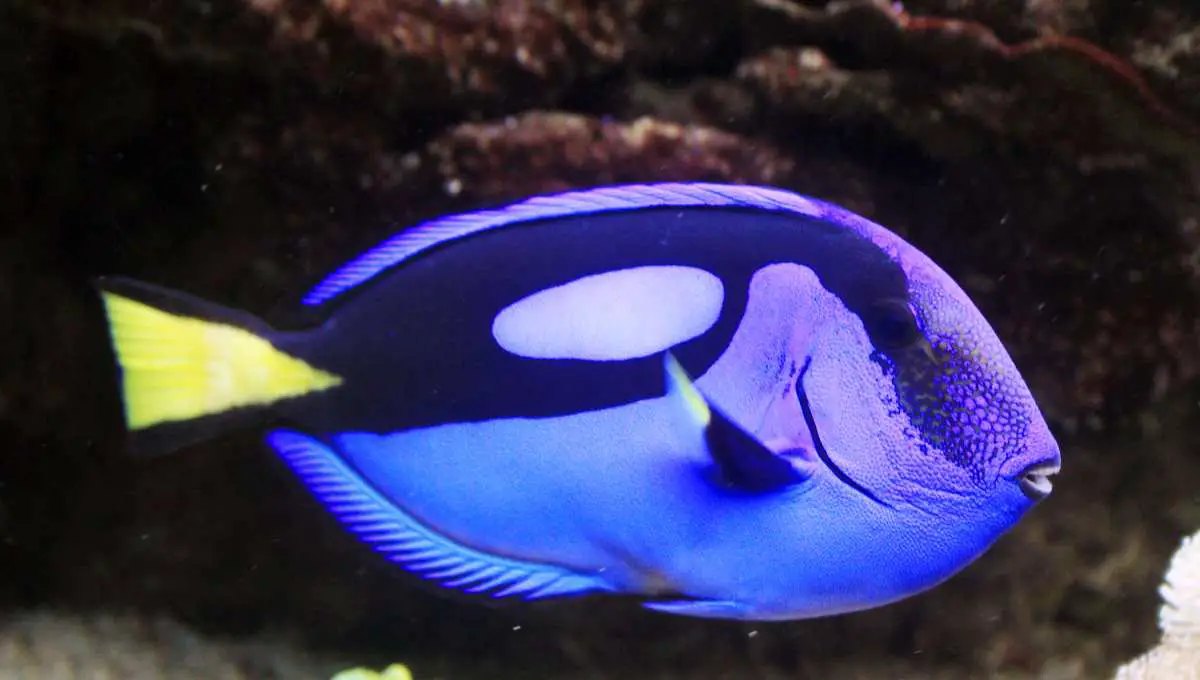
Bellus Angelfish (Genicanthus bellus) are medium-sized angels that are lesser known to the world. These fish belongs to the Eastern Indian Ocean and Western Pacific Ocean. You can identify these fish with their long flowing fins and bright white bodies.
Just like Spotbreast Angelfish, there is a considerable difference between the sexes of Bellus Angelfish. The females are all white with a black band across their body and orange anal fins. At the same time, males have blue highlights on their faces and yellow lines on their tan bodies.
The Queen Angelfish (Holacanthus ciliaris)
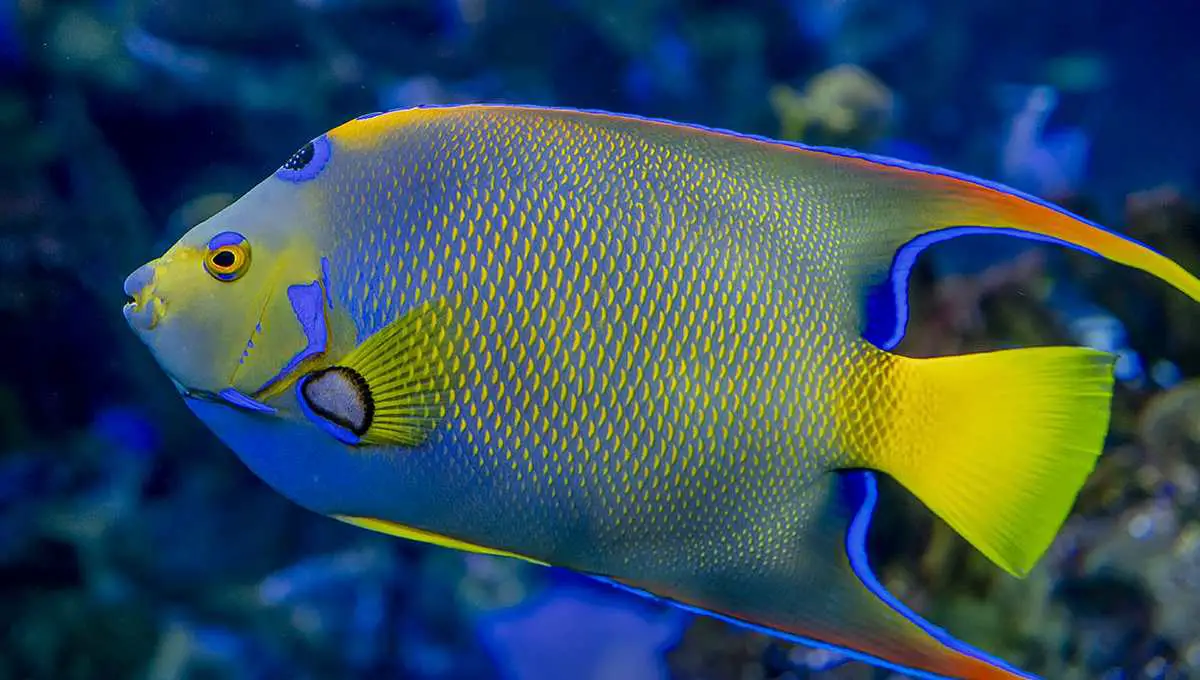
The Queen Angelfish is one of the most popular and well-known angelfish species. They are found throughout the Western Atlantic Ocean and can grow up to 14 inches in length. The Queen Angelfish is easily identified by its bright blue and yellow stripes across their body.
While they are one of the most beautiful angelfish, they are also one of the most difficult to care for. Queen Angelfish need a tank of at least 250 gallons and plenty of live rock to hide in. They are also known to be quite aggressive towards other fish.
Rock Beauty Angelfish (Holacanthus tricolor)

The Rock Beauty Angelfish is a species of saltwater angelfish that is found in the Western Atlantic Ocean. They are easily identified by their bright yellow face and tail with black bodies. Their fins might also have orange linings sometimes. Usually, Rock Beauty Angelfish only grow to be about eight inches in length. But they are very difficult to keep due to their diet and aggression. They need regular meaty diets throughout their lives and should only never be kept with other aggressive fish. A tank of at least 125 gallons is recommended for a single Rock Beauty Angelfish.
Koran Angelfish (Pomacanthus semicirculatus)
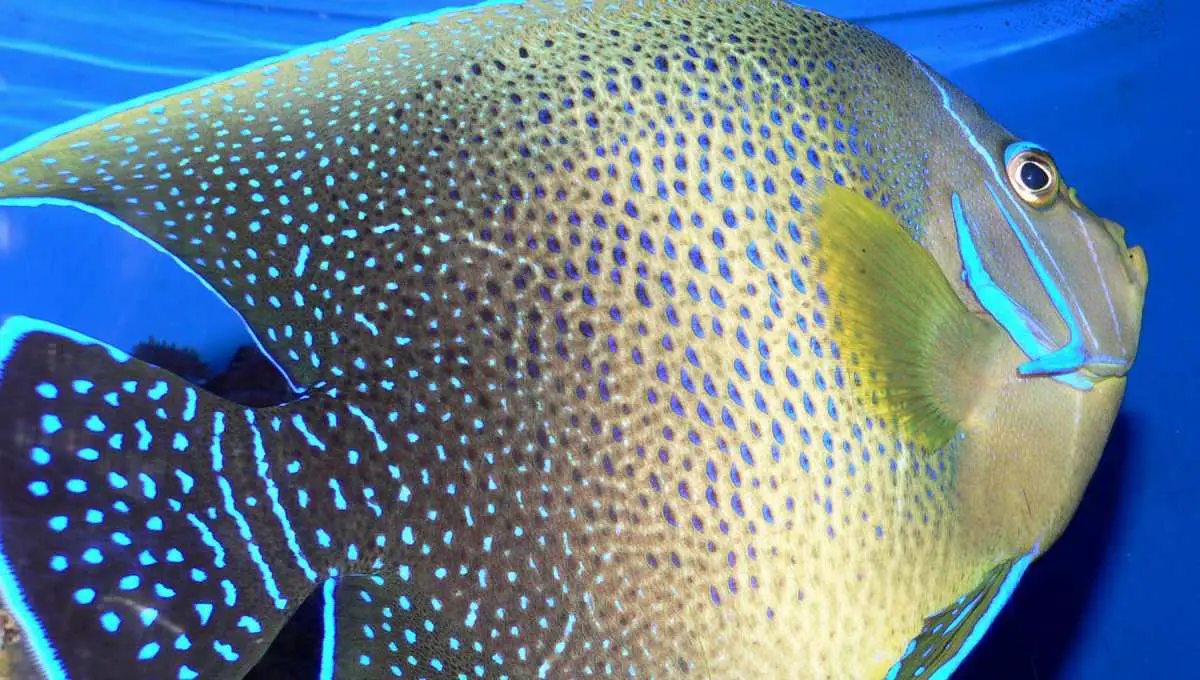
The Koran Angelfish is a species of saltwater angelfish that is found in the Indo- West Pacific Ocean. They are easily identified by their black body with blue and white stripes running down their sides.
Usually, Koran Angelfish only grow to be about 15 inches in length. These fish are quite uncommon in the aquarium trade and are quite difficult to care for. They grow very quickly and are not reef safe.
A tank of at least 250 gallons is recommended for a single Koran Angelfish. It is advisable to have plenty of live rock and a meaty diet ready for when you introduce a Koran Angelfish into your aquarium.
Regal Angelfish (Pygoplites diacanthus)
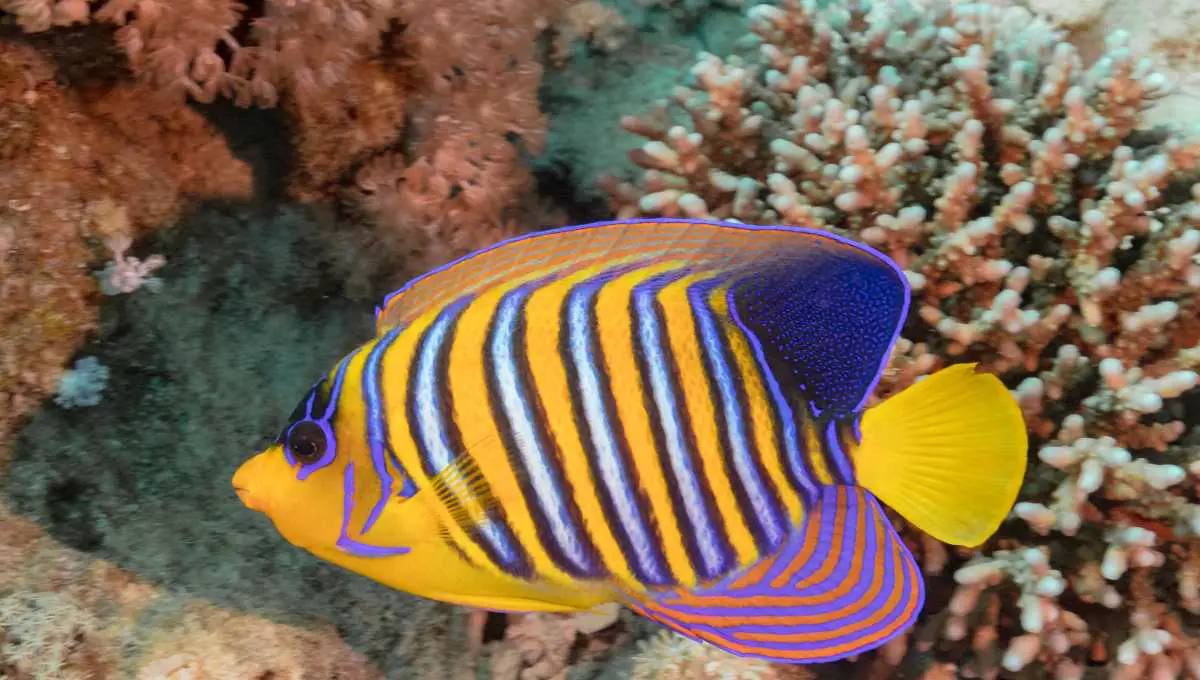
The regal angelfish is a beautiful fish that is native to the Indo-Pacific region. It is yellow in color, with blue, white, black, and orange stripes running vertically down its body. The regal angelfish grow to be about 10 inches long and are a popular fish for both saltwater aquariums and reefs.
The regal angelfish is a carnivore, and its diet consists of small fish, crustaceans, and mollusks. Usually, these fish is a peaceful fish, but they can be aggressive towards other members of the same species. However, it is very difficult to maintain the water parameters of these fish in an aquarium setting. So, they are not recommended for beginner aquarists.
Goldflake Angelfish (Apolemichthys xanthopunctatus)
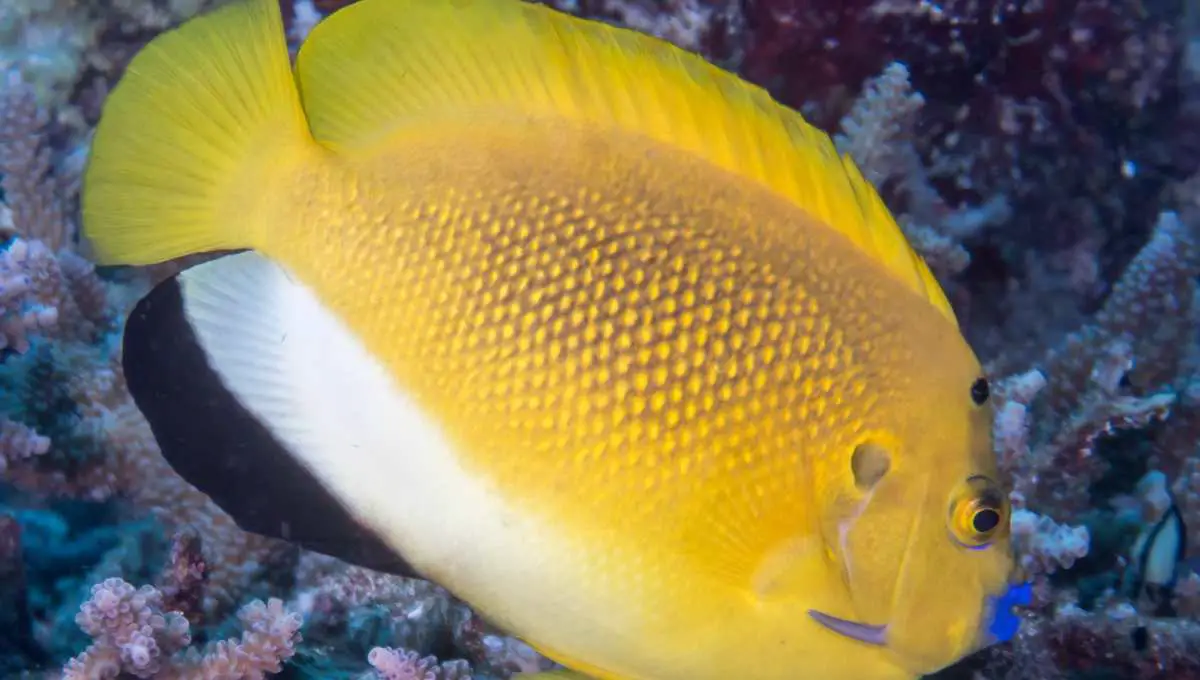
The Goldflake Angelfish is a beautiful fish that is native to the reefs of the Pacific Ocean. This species can grow to be about ten inches long and is characterized by its bright yellow body with black spots. In addition to this, they also have a hit blue color on their lips.
Generally, Goldflake Angelfish is a popular fish among aquarium enthusiasts due to its vibrant colors and easy care requirements. This species is relatively peaceful and can be kept with other peaceful fish in a reef tank.
Majestic Angelfish (Pomacanthus navarchus)

The majestic angelfish is one of the largest members of the Pomacanthus family and can reach up to 12 inches in length. Its body is deep blue, with yellow fins and a conspicuous blue-black band that runs through its eyes.
Generally, Majestic angelfish are one of the most popular fish among aquarists due to their striking colors and graceful swimming motions. However, they need a lot of space to swim and should only be kept in aquariums that are at least 200 gallons.
Blueface Angelfish (Pomacanthus xanthometopon)
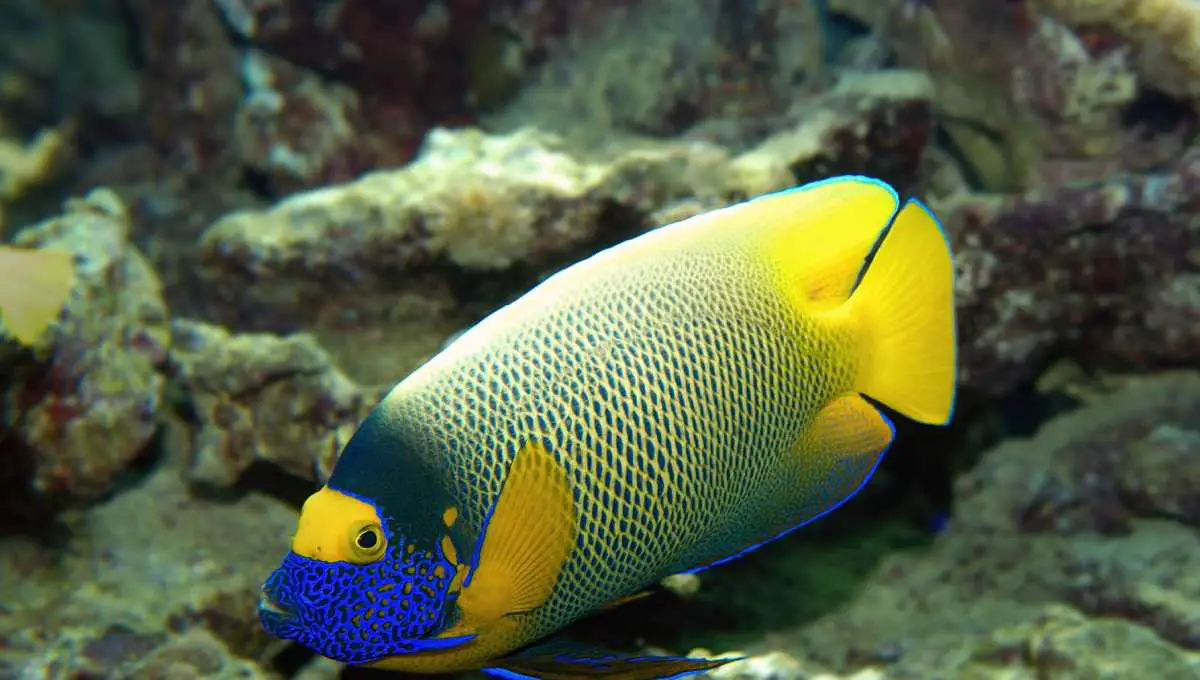
As the name itself suggests, the blue face angelfish has a beautiful blue coloration on its face. The rest of their body is mostly yellow with vertical black and blue stripes. They are reef-dwellers and can be found in the Indo-Atlantic Ocean from Florida to Brazil, including the Gulf of Mexico and the Caribbean Sea.
Usually, Blueface Angelfish adults can grow up to 15 inches. Their body transition starts after they reach about five inches in length. From there, the juveniles go through a stage where their face turns blue gradually, and body changes to grey and yellow.
Moreover, owing to their larger size and adult stage, the Blueface Angelfish are less likely to get bullied or eaten by other fishes. They are known to be quite aggressive and territorial in nature.
So, if you’re planning on keeping a Blueface Angelfish, make sure it is the only angelfish in your aquarium!
How To Keep Saltwater And Freshwater Angelfish Happy And Healthy?
Many of us think that keeping fish is a very easy task, but it is not as easy as it looks. It requires a lot of care, time, and effort to keep the fish healthy and happy. There are two main types of fish: saltwater and freshwater. Both of them have different requirements for their habitat.
However, the general ways to keep both types of Angelfish happy and healthy are:
Selection Of Proper Tank Size
The size of the tank is a very important factor in keeping the fish healthy. The rule of thumb is one gallon per one inch of fish. So, if you have a five-inch Angelfish, you will need at least a five-gallon tank.
Moreover, some fish that are very active and love to swim around a lot need a bigger tank. On the other hand, fish that are not very active and prefers to stay in one place most of the time can live in a smaller tank.
Selection Of Proper Tank Mates
Another important factor in keeping Angelfish healthy is selecting proper tank mates. It is very important to do some research before adding any fish to the tank. Some fish are not compatible with each other, and they can fight with each other, which can lead to injury or even death.
Incompatible fish can also cause stress to the Angelfish, which can make them more susceptible to diseases. So, it is very important to select proper tank mates for the Angelfish.
Proper Diet
A proper diet is very important for the Angelfish to stay healthy. They should be given a variety of food to eat. Some of the things that they can eat are live food, frozen food, pellets, and flakes.
Giving them a variety of food will not only keep them healthy but also help them to stay active.
You can feed them the following food:
- Fluval A6581 Bug Bites Cichlid Pellets
- Amzey Dries Shrimp Fish Foods
- Appetizing Shrimp Mealworms
- Tetra Jumbokrill Jumbo Shrimp
Proper Water Conditions
Another important factor in keeping the Angelfish healthy is maintaining proper water conditions. The water should be of good quality, and it should be changed on a regular basis.
The temperature of the water should also be kept in mind while setting up the tank. Angelfish can live in both cold and warm water, but they prefer water that is around 77 degrees Fahrenheit.
Proper filtration is also very important to keep the water clean and free of harmful chemicals.
Regular Vet Checkups
Just like other pets, Angelfish also need to see a vet on a regular basis. The vet can help to identify any problems that the fish might have and can also give them the proper treatment.
Some of the things that the vet will check are the fish’s weight, appetite, behavior, and appearance.
By following these simple tips, you can keep your Angelfish healthy and happy.
Conclusion
In conclusion, angelfish can be both freshwater and saltwater fish, depending on the species. There are many different types of angelfish, each with its own unique preferences for living conditions. It is important to do your research before purchasing an angelfish to make sure that you can provide the proper environment for your new pet.
Do you have an angelfish? Let us know in the comments below!
Or, If you have any questions or would like to learn more about keeping angelfish, please feel free to leave us in the comments. We would be happy to help you get started on your journey to becoming a fish keeper!
Thanks for reading!







Pingback: 9 Reasons Why Angelfish Hide - Fish Keeping Guide